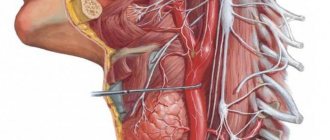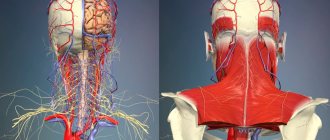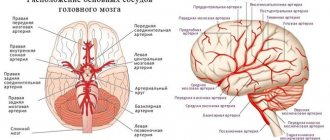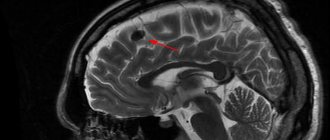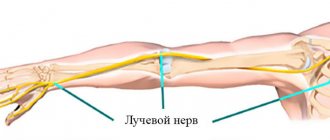Anatomy of Human Spinal Nerves - Information:
Spinal nerves, nn. spinales, are located in the correct order (neuromeres), corresponding to the myotomes (myomeres) of the body and alternating with the segments of the spinal column; Each nerve has a corresponding skin area (dermatome).
A person has 31 pairs of spinal nerves, namely: 8 pairs of cervical, 12 pairs of thoracic, 5 pairs of lumbar, 5 pairs of sacral and 1 pair of coccygeal.
Each spinal nerve leaves the spinal cord with two roots: posterior (sensitive) and anterior (motor); both roots are connected into one trunk, truncus n. spinalis, emerging from the spinal canal through the intervertebral foramen. Near and somewhat outward from the junction, the dorsal root forms a node, ganglion spinale, in which the anterior motor root does not participate. Due to the connection of both roots, spinal nerves are mixed nerves: they contain sensory (afferent) fibers from the cells of the spinal ganglia, motor (efferent) fibers from the cells of the anterior horn, as well as vegetative fibers from the cells of the lateral horns, emerging from the spinal cord as part of the anterior root. Vegetative fibers are also present in the dorsal root.
Autonomic fibers entering the animal nerves through the roots provide processes in the soma such as trophism, vasomotor reactions, etc. In cyclostomes (lampreys), both roots continue into separate nerves - motor and sensory. In the further course of evolution, starting with transverse fish, the roots come closer together and merge, so that the separate course is maintained only for the roots, and the nerves become mixed.
Each spinal nerve, upon exiting the intervertebral foramen, is divided into two branches, respectively, into two parts of the myotome (dorsal and ventral):
- posterior, ramus dorsalis, for the autochthonous muscles of the back and the skin covering it, developing from the dorsal part of the myotome;
- anterior, ramus ventralis, for the ventral wall of the trunk and limbs, developing from the ventral parts of the myotomes.
In addition, two more types of branches depart from the spinal nerve:
- for the innervation of the viscera and blood vessels - connecting branches to the sympathetic trunk, rr. communicantes;
- for innervation of the spinal cord membranes - r. meningeus, going back through the intervertebral foramen.
Posterior branches of the spinal nerves. The posterior branches, rami dorsales, of all spinal nerves go back between the transverse processes of the vertebrae, bending around their articular processes. All of them (with the exception of the I cervical, IV and V sacral and coccygeal) are divided into ramus medialis and ramus lateralis, which supply the skin of the back of the head, the back of the neck and back, as well as the deep spinal muscles.
Posterior branch of the 1st cervical nerve, n. suboccipitalis emerges between the occipital bone and the atlas and then divides into branches supplying mm. recti capitis major et minor, m. semispinalis capitis, mm. obliqui capitis. To skin n. suboccipitalis does not produce branches. Posterior branch of the II cervical nerve, n. occipitalis major, emerging between the posterior arch of the atlas and the second vertebra, then pierces the muscles and, becoming subcutaneous, innervates the occipital region of the head. The rami dorsales of the thoracic nerves are divided into medial and lateral branches, giving branches to the autochthonous muscles; the cutaneous branches of the upper thoracic nerves arise only from the rami mediales, and those of the lower ones - from the rami laterales.
The cutaneous branches of the three upper lumbar nerves go to the upper part of the gluteal region called the nn. clunium superiores, and the cutaneous branches of the sacral ones are called nn. Clunium mediai. Anterior branches of the spinal nerves. The anterior branches, rami ventrales, of the spinal nerves innervate the skin and muscles of the ventral wall of the body and both pairs of limbs. Since the skin of the abdomen in its lower part takes part in the development of the external genitalia, the skin covering them is also innervated by the anterior branches. The latter, except for the first two, are much larger than the hind ones.
The anterior branches of the spinal nerves retain their original metameric structure only in the thoracic region (nn. intercostales). In the remaining sections associated with the limbs, during the development of which segmentation is lost, the fibers extending from the anterior spinal rami are intertwined. This is how nerve plexuses, plexus, are formed, in which fibers of different neuromeres are exchanged. A complex redistribution of fibers occurs in the plexuses: the anterior branch of each spinal nerve supplies its fibers to several peripheral nerves, and, therefore, each of them contains fibers from several segments of the spinal cord.
It is therefore clear that damage to one or another nerve is not accompanied by dysfunction of all muscles receiving innervation from the segments that gave rise to this nerve. Most of the nerves arising from the plexuses are mixed; therefore, the clinical picture of the lesion consists of motor disturbances, sensory disturbances and autonomic disorders. There are three large plexuses: cervical, brachial and lumbosacral. The latter is divided into lumbar, sacral and coccygeal.
Spinal nerves. Spinal nerves (nn
Spinal nerves (nn. spinales) are paired, metamerically located nerve trunks, which are created by the fusion of two roots of the spinal cord - posterior (sensitive) and anterior (motor) (Fig. 133). At the level of the intervertebral foramen, they connect and exit, dividing into three or four branches: anterior, posterior, meningeal white communicating branches; the latter connect to the nodes of the sympathetic trunk. In humans, there are 31 pairs of spinal nerves, which correspond to 31 pairs of spinal cord segments (8 cervical, 12 thoracic, 5 lumbar, 5 sacral and 1 pair of coccygeal nerves). Each pair of spinal nerves innervates a specific area of muscle (myotome), skin (dermatome) and bone (sclerotome). Based on this, segmental innervation of muscles, skin and bones is distinguished.
Rice. 133. Scheme of the formation of the spinal nerve:
1 - trunk of the spinal nerve; 2 - anterior (motor) root; 3—posterior (sensitive) root; 4— radicular threads; 5—spinal (sensitive) node; 6— medial part of the posterior branch; 7—lateral part of the posterior branch; 8 - posterior branch; 9 - anterior branch; 10 - white branch; 11 - gray branch; 12 - meningeal branch.
The posterior branches of the spinal nerves innervate the deep muscles of the back, the back of the head, as well as the skin of the back of the head and torso. The posterior branches of the cervical, thoracic, lumbar, sacral and coccygeal nerves are distinguished.
The posterior branch of the first cervical spinal nerve (C1) is called the suboccipital nerve. It innervates the rectus capitis posterior major and minor, the superior and inferior oblique capitis muscles, and the semispinalis capitis muscle.
The posterior branch of the second cervical spinal nerve (CII) is called the greater occipital nerve, is divided into short muscular branches and a long cutaneous branch, and innervates the muscles of the head and skin of the occipital region.
The anterior branches of the spinal nerves are much thicker and longer than the posterior ones. They innervate the skin, muscles of the neck, chest, abdomen, upper and lower extremities. Unlike the posterior branches, the metameric (segmental) structure is preserved by the anterior branches of only the thoracic spinal nerves. The anterior branches of the cervical, lumbar, sacral and coccygeal spinal nerves form plexuses (plexus). There are cervical, brachial, lumbar, sacral and coccygeal nerve plexuses.
The cervical plexus is formed by the anterior branches of the four superior cervical (CI - CIV) spinal nerves, connected by three arcuate loops and lies on the deep muscles of the neck. The cervical plexus connects to the accessory and hypoglossal nerves. The cervical plexus has motor (muscle), cutaneous and mixed nerves and branches. The muscle nerves innervate the trapezius, sternomuscular-mastoid muscles, give branches to the deep muscles of the neck, and the subhyoid muscles receive innervation from the cervical loop. The cutaneous (sensory) nerves of the cervical plexus give rise to the greater auricular nerve, the lesser occipital nerve, the transverse cervical nerve, and the supraclavicular nerves. The greater auricular nerve innervates the skin of the auricle and external auditory canal; lesser occipital nerve - skin of the lateral occipital region; the transverse cervical nerve supplies innervation to the skin of the anterior and lateral neck; The supraclavicular nerves innervate the skin above and below the collarbone.
The largest nerve of the cervical plexus is the phrenic nerve. It is mixed, formed from the anterior branches of the III-V cervical spinal nerves, passes into the chest and ends in the thickness of the diaphragm.
The motor fibers of the phrenic nerve innervate the diaphragm, and the sensory fibers innervate the pericardium and pleura.
The brachial plexus (Fig. 134) is formed by the anterior branches of the four lower cervical (CV - CVIII) nerves, part of the anterior branch of the first cervical (CIV) and thoracic (ThI) spinal nerves.
Rice. 134. Brachial plexus (diagram):
1 - phrenic nerve; 2 - dorsal nerve of the scapula; 3 - upper trunk of the brachial plexus; 4 - middle trunk of the brachial plexus; 5 - subclavian trunk; 6 - lower trunk, brachial plexus; 7 - accessory phrenic nerves; 8 - long thoracic nerve; 9 - medial thoracic nerve; 10 - lateral pectoral nerve; 11 - medial bundle; 12 - rear beam; 13 - lateral bundle; 14 - suprascapular nerve
In the interstitial space, the anterior branches form three trunks - upper, middle and lower. These trunks are divided into a number of branches and directed into the axillary fossa, where they form three bundles (lateral, medial and posterior) and surround the axillary artery on three sides. The trunks of the brachial plexus, together with their branches lying above the clavicle, are called the supraclavicular part, and with the branches lying below the clavicle, the subclavian part. The branches that extend from the brachial plexus are divided into short and long. The short branches innervate mainly the bones and soft tissues of the shoulder girdle, the long branches innervate the free upper limb.
The short branches of the brachial plexus include the dorsal nerve of the scapula - it innervates the levator scapulae muscle, the rhomboid major and minor muscles; long thoracic nerve - serratus anterior muscle; subclavian - the muscle of the same name; suprascapular - supra- and cavitary muscles, capsule of the shoulder joint; subscapularis - the same name and teres major muscles; thoracodorsal - latissimus dorsi muscle; lateral and medial pectoral nerves—muscles of the same name; axillary nerve - deltoid and teres minor muscles, capsule of the shoulder joint, as well as the skin of the upper parts of the lateral surface of the shoulder.
The long branches of the brachial plexus originate from the lateral, medial and posterior bundles of the infraclavicular part of the brachial plexus (Fig. 135, A, B).
Rice. 135. Nerves of the shoulder, forearm and hand:
A - nerves of the shoulder: 1 - medial cutaneous nerve of the shoulder and medial cutaneous nerve of the forearm; 2 - median nerve; 3 - brachial artery; 4 - ulnar nerve; 5 - biceps brachii (distal end); 6—radial nerve; 7—brachial muscle; 8—musculocutaneous nerve; 9—biceps brachii (proximal end); B - nerves of the forearm and hand: 1 - median nerve; 2 - pronator teres (crossed); 3 - ulnar nerve; 4 - deep flexor of the fingers; 5—anterior interosseous nerve; 6— dorsal branch of the ulnar nerve; 7— deep branch of the ulnar nerve; 8 - superficial branch of the ulnar nerve; 9 - pronator quadratus (crossed); 10 - superficial branch of the radial nerve; //—brachioradialis muscle (crossed); 12 - radial nerve
The musculocutaneous nerve originates from the lateral fascicle and gives its branches to the brachiocoracoid, biceps and brachialis muscles. Having given branches to the elbow joint, the nerve descends as a lateral cutaneous nerve. It innervates part of the skin of the forearm.
The median nerve is formed by the fusion of two roots from the lateral and medial bundles on the anterior surface of the axillary artery. The nerve gives its first branches to the elbow joint, then, descending lower, to the anterior muscles of the forearm. In the palm, the subpalmar aponeurosis divides the median nerve into terminal branches that innervate the muscles of the thumb, except for the adductor pollicis muscle. The median nerve also innervates the wrist joints, the first four fingers and part of the lumbrical muscles, the skin of the dorsal and palmar surfaces.
The ulnar nerve begins from the medial bundle of the brachial plexus, runs along the inner surface of the shoulder with the brachial artery, where it gives no branches, then goes around the medial epicondyle of the humerus and passes to the forearm, where it runs along with the ulnar artery in the groove of the same name. In the forearm, it innervates the flexor carpi ulnaris and part of the flexor digitorum profundus. In the lower third of the forearm, the ulnar nerve divides into dorsal and palmar branches, which then pass to the hand. On the hand, the branches of the ulnar nerve innervate the adductor pollicis muscle, all interosseous muscles, two lumbrical muscles, the muscles of the little finger, the skin of the palmar surface at the level of the fifth finger and the ulnar edge of the fourth finger, the skin of the dorsal surface at the level of the fifth, fourth and ulnar side of the third finger.
The medial cutaneous nerve of the shoulder emerges from the medial bundle, gives off branches to the skin of the shoulder, accompanies the brachial artery, and connects in the axillary fossa with the lateral branch of the II, and sometimes III, intercostal nerves.
The medial cutaneous nerve of the forearm is also a branch of the medial bundle and innervates the skin of the forearm.
The radial nerve originates from the posterior bundle of the brachial plexus and is the thickest nerve. On the shoulder, in the brachiomuscular canal, it passes between the humerus and the heads of the triceps muscle, giving off muscle branches to this muscle and skin branches to the posterior surface of the shoulder and forearm. In the lateral groove, the ulnar fossa is divided into deep and superficial branches. The deep branch innervates all the muscles of the posterior surface of the forearm (extensors), and the superficial branch runs in the groove along with the radial artery, passes to the back of the hand, where it innervates the skin of 2 1/2 fingers, starting from the thumb.
The anterior branches of the thoracic spinal nerves (ThI-ThXII), 12 pairs, run in the intercostal spaces and are called intercostal nerves. An exception is the anterior branch of the XII thoracic nerve, which passes under the XII rib and is called the subcostal nerve. The intercostal nerves run in the intercostal spaces between the internal and external intercostal muscles and do not form plexuses. Six superior intercostal nerves on both sides reach the sternum, and five lower costal nerves and the subcostal nerve continue to the anterior wall of the abdomen.
The anterior branches innervate the intrinsic muscles of the chest, participate in the innervation of the muscles of the anterior wall of the abdominal cavity and give off anterior and lateral cutaneous branches, innervating the skin of the chest and abdomen.
The lumbosacral plexus (Fig. 136) is formed by the anterior branches of the lumbar and sacral spinal nerves, which, connecting with each other, form the lumbar and sacral plexuses. The connecting link between these plexuses is the lumbosacral trunk.
Rice. 136. Lumbosacral plexus:
1-posterior branches of the lumbar nerves; 2- anterior branches of the lumbar nerves; 3- iliohypogastric nerve; 4- genitofemoral nerve; 5-ilioinguinal nerve; 6 - lateral cutaneous nerve of the thigh; 7- femoral branch; 8- reproductive branch; 9 - anterior scrotal nerves; 10 - anterior branch of the obturator nerve; 11 - obturator nerve; 12 - lumbosacral plexus; 13 - anterior branches of the sacral plexus
The lumbar plexus is formed by the anterior branches of the three upper lumbar and partially by the anterior branches of the XII thoracic and IV lumbar spinal nerves. It lies anterior to the transverse processes of the lumbar vertebrae in the thickness of the psoas major muscle and on the anterior surface of the quadratus lumborum muscle. All anterior branches of the lumbar nerves give rise to short muscular branches that innervate the psoas major and minor, quadratus lumborum, and interlumbar lateralis muscles.
The largest branches of the lumbar plexus are the femoral and obturator nerves.
The femoral nerve is formed by three roots, which first go deep into the psoas major muscle and connect at the level of the V lumbar vertebra, forming the trunk of the femoral nerve. Heading down, the femoral nerve is located in the groove between the psoas major and iliacus muscles. The nerve enters the thigh through the muscle lacuna, where it gives branches to the anterior muscles of the thigh and the skin of the anteromedial surface of the thigh. The longest branch of the femoral nerve is the saphenous nerve of the thigh. The latter, together with the femoral artery, enters the adductor canal, then, together with the descending knee artery, follows along the medial surface of the leg to the foot. On its way it innervates the skin of the knee joint, patella, and partially the skin of the lower leg and foot.
The obturator nerve is the second largest branch of the lumbar plexus. From the lumbar region, the nerve descends along the medial edge of the psoas major muscle into the small pelvis, where, together with the artery and vein of the same name, it passes through the obturator canal to the thigh, gives off muscle branches to the adductor muscles of the thigh and divides into two final branches: anterior (innervates the skin of the medial surface of the thigh) and posterior (innervates the obturator externus, adductor magnus muscles, and hip joint).
In addition, larger branches depart from the lumbar plexus: 1) iliohypogastric nerve - innervates the muscles and skin of the anterior abdominal wall, part of the buttock region and thighs; 2) ilioinguinal nerve - innervates the skin of the pubis, groin area, root of the penis, scrotum (skin of the labia majora); 3) genital femoral nerve - is divided into two branches: genital and femoral. The first branch innervates part of the skin of the thigh, in men - the muscle that lifts the testicle, the skin of the scrotum, and the meatus; in women - the round uterine ligament and the skin of the labia majora. The femoral branch passes through the vascular lacuna to the thigh, where it innervates the skin of the inguinal ligament and the region of the femoral canal; 4) lateral cutaneous nerve of the thigh - leaves the pelvic cavity on the thigh, innervates the skin of the lateral surface of the thigh to the knee joint.
The sacral plexus is formed by the anterior branches of the upper four sacral, V lumbar and partially IV lumbar spinal nerves. The anterior branches of the latter form the lumbosacral trunk. It descends into the pelvic cavity and connects with the anterior branches of the I - IV sacral spinal nerves. The branches of the sacral plexus are divided into short and long.
The short branches of the sacral plexus include the superior and inferior gluteal nerves (Fig. 137), the pudendal nerve, the obturator internus and piriformis, and the quadratus femoris nerve. The last three nerves are motor and innervate the muscles of the same name through the infrapiriformis foramen.
Rice. 137. Nerves of the gluteal region and posterior thigh:
1 - superior gluteal nerve; 2—sciatic nerve; 3.4—muscular branches of the sciatic nerve; 5 - tibial nerve; 6 - common peroneal nerve; 7—lateral cutaneous nerve of the calf; 8- posterior cutaneous nerve of the thigh; 9 - inferior gluteal nerve; 10— medial dorsal cutaneous nerve
The superior gluteal nerve from the pelvic cavity through the supragiriform foramen, together with the superior gluteal artery and vein, passes between the gluteus minimus and medius muscles. Innervates the gluteal muscles, as well as the muscle that strains the fascia lata of the thigh.
The inferior gluteal nerve exits the pelvis through the piriformis foramen and innervates the gluteus maximus muscle.
The long branches of the sacral plexus are represented by the posterior cutaneous nerve of the thigh, which innervates the skin of the gluteal region and partially the skin of the perineum, and the sciatic nerve (Fig. 138).
Fig. 138. Nerves of the lower leg (posterior surface):
1 - sciatic nerve; 2 - common peroneal nerve; 3— tibial nerve; 4, 7,8—muscular branches of the tibial nerve; 5 - lateral cutaneous nerve of the calf; 6 - muscular branches of the peroneal nerve
The sciatic nerve is the largest nerve in the human body. It leaves the pelvic cavity through the infrapiriform foramen, goes down and, at the level of the lower third of the thigh, divides into the tibial and common peroneal nerves. They innervate the posterior muscle group on the thigh.
The tibial nerve passes in the popliteal fossa, on its way it gives branches to the knee joint, triceps surae, plantar and popliteal muscles. Going down, the nerve goes to the lower leg and gives branches to the muscles. In the popliteal fossa, the medial cutaneous nerve of the calf departs from the tibial nerve, which in the lower third of the leg connects with the branch of the lateral cutaneous nerve of the calf and form the sural nerve. It innervates the skin of the lateral part of the foot and ankle. At the medial malleolus, the tibial nerve divides into the medial and lateral plantar nerves. These nerves innervate the muscles, skin and joints of the foot.
The common peroneal nerve, having separated from the sciatic nerve, goes laterally down to the lower leg and is divided into superficial and deep. The superficial peroneal nerve passes through the superior musculofibular canal, gives branches to the long and short peroneal muscles, and exits to the dorsum of the foot, where it innervates the skin of the dorsum of the foot and fingers. The deep peroneal nerve runs along the anterior surface of the interosseous membrane and exits onto the dorsum of the foot; innervates the anterior muscles of the lower leg, foot, ankle joint, part of the skin of the 1st and 2nd toes.
The coccygeal plexus is formed by the anterior branches of the last sacral and coccygeal spinal nerves. It is located on the coccygeus muscle, giving off branches to the skin in the area of the coccyx and anus.
